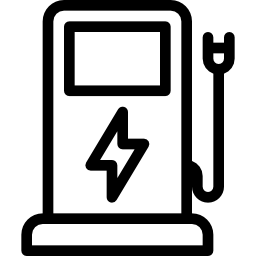[su_row]
[su_column size=”3/5″] A U.S. Department of Energy study showed that over 60% of EV charging took place at homes, so it is important to find a good EV charger for your home.
There are also a range of models and features, so OhmHome has compiled this guide on the best EV chargers after spending over 40 hours researching public data, testing products in the field and talking to electricians.
Depending on what state you live in, you may be able to take advantage of utility incentives or state rebates, so be sure to read this section of the guide.
[/su_column]
[su_column size=”2/5″]

[/su_column]
[/su_row]
Our Summary Recommendation

After researching and reviewing all models, we recommend the Siemens VC30GRYU Versicharge 30-Amp for most EV owners, as it is the best value for the top manufactures ($100 less expensive than the other models). The Siemens base model is not Wifi-enabled (which is why the cost is more manageable), but many EV owners claim to be fine without the connectivity features.
The Siemens model also has a simple design and very distinct charging indicators, which owners appreciate. Note for Tesla owners, we recommend the Tesla-built Wall Connector or Mobile Connector.
Many consumers tell us that it can be difficult to find electricians with specific EV charger experience. It may be worth checking out Amazon Home Services EV Charger Installation (the reviews have been excellent so far).
[su_button url=”http://amzn.to/2plGbXg” target=”blank” style=”flat” size=”6″ radius=”0″ class=”view-amz”]EV Charger Installation Service on Amazon[/su_button]
Best EV Chargers 2017: Overview
[su_list icon=”icon: angle-double-right” icon_color=”#4dc7ec” class=”table-of-cont”]
- Model Comparison Table
- EV Chargers 101
- Detailed Reviews
- EV Charger Incentives
- Installation Tips and Costs
[/su_list]
Best EV Chargers: Comparison
EV Chargers 101
The question that many 1st time drivers ask immediately after their EV purchase is, “What charger should I buy?” Before finding a charger that fits your needs, it is important to understand a few basic concepts about EV chargers and think through a few important considerations.
Do I Even Need to Buy an EV Charger for Home?
EVs come with a 120-volt or Level one cord that can be plugged into any wall outlet. But the charging times are between 3-5 miles per hour, so if your commute is longer than 30 miles a day (4 x 8 hours = 32) this might not be a good fit for you. You will likely need a Level 2 charger, which charges 10-20 miles per hour and is the route most EV users choose. Public charging infrastructure has increased significantly (search the Department of Energy’s charging locator for stations near you) and if you can access a public charger during the day, you may be able to get by without purchasing a home charger.
Simplicity or Connectivity?
Two of the models that we reviewed, the ChargePoint 32-Amp and the Juicebox 40-Amp have base models that are Wifi-enabled and the Siemens Versicharge has a Wifi add-on. The Wifi connectivity and smart phone apps (video preview of Chevy Bolt app) let you monitor and control charging times, but many longtime EV owners swear by the simplicity of basic models. Most EVs have charging timers and controls on board, so it is not 100% necessary to have the Wifi connectivity. Another option if you are interested in monitoring your energy usage beyond your electric vehicle is a connected home energy monitor.
Charger Location and Portability
EV chargers can either by “hardwired” or plug-in and we recommend a plug-in installation for portability. In a hardwired installation the EV charger has wiring connected directly to the home’s electrical circuit. A hardwired unit can be removed if you move, but requires an electrician. In a plug-in installation, the EV charger has a plug that can be used with a 240V outlet, which is the same voltage as a clothes dryer outlet (typically a NEMA 14-50 is used). If you move or want to swap out your EV, all you need to do is unplug it. Note that in some cities, a hardwired installation is required if the EV charger is outside. If you are unfamiliar with electric panel basics, read this helpful overview from the DIY network.
Charging Rates Per EV Models and EV Chargers
We reviewed EV Chargers with at least 30-Amps (the JuiceBox is 40 Amps), which equates to just over 7kWs of power (240V x 30 Amps) and most EV models are able to charge at these rates. The 30 Amp EV charger equates to about 20 miles per hour of charging while a 15 Amp equates to 8-10 miles per hour of charging. There are some lower range models that are in the 3.3 kW range, including the Chevy Spark or Ford Fusion Energi. If the charging rate of your EV is in the 3.3 kW range, you will not have faster charging with a 30-Amp model, but it may be worth the investment if you plan on purchasing another EV or just want to have visitors be able to charge at higher rates. Review the full guide of charging times by vehicle model for further details.
[su_box title=”Key Electric Vehicle Charger Terms” style=”soft” box_color=”#15a4df” class=”ac-charge”]
[su_accordion class=”ac-charge”]
[su_spoiler title=”On-board Chargers” style=”fancy” icon=”plus-circle”] Electric car batteries use DC power, so the AC power that comes from a home needs to be converted to DC before it can be used by the car. The conversion device for Level One and Level Two chargers (see discussion below) comes factory-installed in an EV (“on-board”) where as a DC Fast Charging station has an device within the station. [/su_spoiler]
[su_spoiler title=”EVSE” style=”fancy” icon=”plus-circle”] EVSE stands for Electric Vehicle Service Equipment and is a fancy term for the charging equipment that will be installed in your home. The main purpose is to ensure that the AC power from your home is channeled safely into your EV. [/su_spoiler]
[su_spoiler title=”Charger Levels” style=”fancy” icon=”plus-circle”] Chargers are categorized in levels based on their charging rates, as discussed below. Note that DC Fast Charging (Level Three) is not currently available for home installations. [/su_spoiler]
[/su_accordion]
[/su_box]
Read this overview on EV charger levels to determine the best fit for your driving needs. Not all homeowners need to purchase an EVSE.
[su_box title=”EV Charger Levels” style=”soft” box_color=”#15a4df” class=”ac-charge”]
[su_accordion class=”ac-charge”]
[su_spoiler title=”Level One (120 Volts – 3-5 Miles Per Hour of Charging)” style=”fancy” icon=”plus-circle”]
Level 1 charging uses a 120-volt current, which is the standard for household outlets and only requires a power cord that comes with your EV. Many residents can charge in their garage without any electrical upgrades.
Level 1 charging uses a 120-volt current, which is the standard for household outlets and only requires a power cord that comes with your EV. Many residents can charge in their garage without any electrical upgrades.
Advantages:
- No equipment purchases or installation costs required
Disadvantages:
- The charge time is slow at only 3-5 miles per hour of charging. Depending on your daily driving needs, this may be adequate with an overnight charge
- Low impact on peak demand charges
[/su_spoiler]
[su_spoiler title=”Level Two (240 Volts – 10-20 Miles Per Hour of Charging)” style=”fancy” icon=”plus-circle”]
Level 2 charging uses 240 volt power to enable faster regeneration of an EV’s battery system. Providing this type of charging requires installation of an EVSE unit and electrical wiring capable of handling higher voltage power (similar outlet as a dryer unit). Homeowners interested in Level 2 chargers should find a qualified electrician to install the charging equipment.
Advantages:
- Fast and convenient charging at home even for higher daily mileage users
Disadvantages:
- Equipment ($700) and installation ($300+) can cost approximately $1,000 and needs to be done by a qualified electrician
[/su_spoiler]
[su_spoiler title=”Level Three (DC Fast Charging)” style=”fancy” icon=”plus-circle”]
DC fast charging provides compatible vehicles with an 80 percent charge in 20-30 minutes by converting high
voltage AC power to DC power for direct storage in EV batteries. Automakers currently have two competing specifications for DC fast charging plugs, the CHAdeMO (Nissan, Tesla, Kia) and SAE Combo standards (BMW, Chevy).
[/su_spoiler]
[/su_accordion]
[/su_box]
Best EV Chargers: Detailed Reviews
Most homeowners buy chargers online to save money and then find a certified electrician for the installation. Below are the top models as reviewed by OhmHome.
JuiceBox Pro 40-Amp EV Charger – Pricey with Connected Features, Great for California
[su_heading size=”7″ align=”right” margin=”0″ class=”view-amz”][su_button url=”http://amzn.to/2wxLrse” target=”blank” style=”flat” size=”5″ radius=”0″]VIEW ON AMAZON[/su_button][/su_heading]
The $599 JuiceBox model offers WiFi connectivity and can connect to Alexa and other smart home devices for homeowners looking to manage charging scheduling remotely. The manufacturer of the Juicebox, eMotorWerks, offers the JuicePoints rewards program, which will compensate EV owners in California for allowing the utility to schedule the EV’s charging around peak demand periods.
The JuiceBox has slightly higher amperage than other models at 40 vs. 30 or 32, but unless you have a Telsa or Chevy Volt, the charging speed will not differ. So the JuiceBox might be a smart investment if you plan on upgrading your EV in the distant future. The JuiceBox also comes in a 75 amp model.
Although the JuiceBox has received some negative points from consumers regarding the lack of external charging indicators and installation quirks, the recent 2017 model has addressed these concerns. Our only complaint about the JuiceBox is its unwieldy chord, which is heavy and can be hard to hang up on the wall mount.
eMotorWerks is also leading a lot of the innovation in the EV industry, recently announcing a peer-to-peer charging marketplace in California via blockchain technology. eMotorWerks was founded in 2010 and is backed by crowdfunding and several small venture rounds.
Pros/Cons
[su_row]
[su_column size=”1/2″ class=”column-pros”]
[su_box title=”Pros” box_color=”#68AF00″ radius=”0″ class=”box-pros” ]
[su_list icon=”icon: check-circle” icon_color=”#68AF00″ ]
- Wifi connectivity
- Access to utility demand response programs in California
- Higher amperage than competing models
- Backed by innovative company
[/su_list]
[/su_box]
[/su_column]
[su_column size=”1/2″ class=”column-cons”]
[su_box title=”Cons” box_color=”#FF0909″ radius=”0″ class=”box-cons” ]
[su_list icon=”icon: times-circle” icon_color=”#FF0909″]
- Harder to install than other models
[/su_list]
[/su_box]
[/su_column]
[/su_row]
[su_divider top=”no” divider_color=”#4dc7ec”]
Siemens VC30GRYU Versicharge 30-Amp – Simple Design and Easy to Use

Siemens is one of the most affordable options on the market. Although it does not include WiFi connectivity, this model offers a timer feature to delay charging in increments of 2 hours (to avoid peak rates). Consumers like the simplicity of the design and large indicator lights that can be seen from across the garage or from a window. Charging scheduling can also be done via most EV models. The model is a bit bulkier, so may not be the best fit for homeowners with limited space.
In addition the the time delay feature, the Siemens model has an adjustable power setting from 7.2 KW to 1.8 KW, which can be used to take advantage of utility savings programs. The unit is Underwriters Laboratories listed for quality standards.
Siemens is one of the most established brands in the EV charge business and continues to invest heavily in its EV charger business, recently announcing an investment in the Chargepoint network.
Pros/Cons
[su_row]
[su_column size=”1/2″ class=”column-pros”]
[su_box title=”Pros” box_color=”#68AF00″ radius=”0″ class=”box-pros” ]
[su_list icon=”icon: check-circle” icon_color=”#68AF00″ ]
- Distinct charging indicator lights
- Easy delay start feature
- Best in class 3 year warranty
[/su_list]
[/su_box]
[/su_column]
[su_column size=”1/2″ class=”column-cons”]
[su_box title=”Cons” box_color=”#FF0909″ radius=”0″ class=”box-cons” ]
[su_list icon=”icon: times-circle” icon_color=”#FF0909″]
- Larger than other models
- Reports of poor customer service if issues arise
[/su_list]
[/su_box]
[/su_column]
[/su_row]
[su_divider top=”no” divider_color=”#4dc7ec”]
ChargePoint 32-Amp – Light and Sleek with Advanced Connectivity
[su_heading size=”7″ align=”right” margin=”0″ class=”view-amz”][su_button url=”http://amzn.to/2osudee” target=”blank” style=”flat” size=”5″ radius=”0″]VIEW ON AMAZON[/su_button][/su_heading]
The Chargepoint is WiFi enabled and comes with a smart phone app, so that homeowners can monitor their charging rates and history both at home and within the Chargepoint charger network. As of July 2017, the ChargePoint network included 38,000 total charging spots and 569 DC fast charging stations. It has the world’s largest and most open EV charging network and has raised nearly $300 million to support its expansion.
The model is also compatible with Nest, so owners can view their charging sessions on their Nest Home report. The Chargepoint model is only 11.2 x 7 or smaller than a standard letter-sized paper.
Pros/Cons
[su_row]
[su_column size=”1/2″ class=”column-pros”]
[su_box title=”Pros” box_color=”#68AF00″ radius=”0″ class=”box-pros” ]
[su_list icon=”icon: check-circle” icon_color=”#68AF00″ ]
- Sleek and lightweight
- Monitoring app
- Can connect app to Chargepoint network
[/su_list]
[/su_box]
[/su_column]
[su_column size=”1/2″ class=”column-cons”]
[su_box title=”Cons” box_color=”#FF0909″ radius=”0″ class=”box-cons” ]
[su_list icon=”icon: times-circle” icon_color=”#FF0909″]
- Does not allow for adjusting the charge current
[/su_list]
[/su_box]
[/su_column]
[/su_row]
[su_divider top=”no” divider_color=”#4dc7ec”]
ClipperCreek HCS-40P – Sturdy, Made in America Without the Frills
[su_heading size=”7″ align=”right” margin=”0″ class=”view-amz”][su_button url=”http://amzn.to/2GMSlyK” target=”blank” style=”flat” size=”5″ radius=”0″]VIEW ON AMAZON[/su_button][/su_heading]
The Clipper Creek is one of the more expensive models, but does not come with add-on features like smart phone apps or Wi-Fi connectivity that other similarly priced models offer. The ClipperCreek model has 32 amps of power and is NEMA 14-50 compatible. The model is related for indoor and outdoor usage and comes with a 25 foot charging cable.
Pros/Cons
[su_row]
[su_column size=”1/2″ class=”column-pros”]
[su_box title=”Pros” box_color=”#68AF00″ radius=”0″ class=”box-pros” ]
[su_list icon=”icon: check-circle” icon_color=”#68AF00″ ]
- Best in class 3 year warranty
- Made in America
- Sturdy construction
[/su_list]
[/su_box]
[/su_column]
[su_column size=”1/2″ class=”column-cons”]
[su_box title=”Cons” box_color=”#FF0909″ radius=”0″ class=”box-cons” ]
[su_list icon=”icon: times-circle” icon_color=”#FF0909″]
- Basic features only
- Not wifi-fi enabled
[/su_list]
[/su_box]
[/su_column]
[/su_row]
[su_divider top=”no” divider_color=”#4dc7ec”]
Other EV Charger Models
There are several EV chargers that we researched, but did not review in detail that are worth considering:
EV Charger Chords
Other Wall-Mounted EV Chargers
EV Charger Incentives
Electricity Rates
Many utilities, particularly in California will offer EV time-of-use rates to promote the charging of EVs during times with the lowest demand and cost of electricity (usually midnight to 5:00 AM). In the summer when air conditioning demand is high during the day, off peak rates can be more than 50% cheaper than on peak rates and can offer significant savings.
Rebates
Many states or utilities will offer EV charger rebates and a list can be found at Plugin America. In 2016, there was a federal incentive via the Alternative Fuel Vehicle Refueling Property Credit, which offered up to $1,000 per location, but the program has not been extended to 2017.
EV Charger Installation Tips
EV charger installations are fairly straightforward, but should be done by a qualified electrician. The general view is that an EV charger installation can be done by any qualified electrician, so homeowners do not need to pay a premium for a specialized EV charger installer. The cost of an installation will vary from $200 to over $1,000 depending on the amount of wiring required. If the EV charger is installed far away from the home’s breaker box (service panel) or the installation requires a service panel upgrade, the cost could be closer to $1,000.
Installation Video
[su_note note_color=”#d8f4fd” text_color=”#ffffff” radius=”3″ class=””]
OhmHome 2017 Product Guides:
- Electric Vehicle Chargers
- Smart Home Gadgets
- Solar Panels For Camping
- Home Energy Monitors
- Smart Light Bulbs
- Smart Thermostats
- Marine Solar Panels
- Portable Solar Chargers
- DIY Solar Panel Kits
- Smart Home Hubs
[/su_note]







